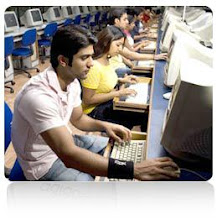The title of forefather of today's all-electronic digital computers is usually awarded to ENIAC, which stood for Electronic Numerical Integrator and Calculator. ENIAC was built at the University of Pennsylvania between 1943 and 1945 by two professors, John Mauchly and the 24 year old J. Presper Eckert, who got funding from the war department after promising they could build a machine that would replace all the "computers", meaning the women who were employed calculating the firing tables for the army's artillery guns. The day that Mauchly and Eckert saw the first small piece of ENIAC work, the persons they ran to bring to their lab to show off their progress were some of these female computers (one of whom remarked, "I was astounded that it took all this equipment to multiply 5 by 1000").
ENIAC filled a 20 by 40 foot room, weighed 30 tons, and used more than 18,000 vacuum tubes. Like the Mark I, ENIAC employed paper card readers obtained from IBM (these were a regular product for IBM, as they were a long established part of business accounting machines, IBM's forte). When operating, the ENIAC was silent but you knew it was on as the 18,000 vacuum tubes each generated waste heat like a light bulb and all this heat (174,000 watts of heat) meant that the computer could only be operated in a specially designed room with its own heavy duty air conditioning system. Only the left half of ENIAC is visible in the first picture, the right half was basically a mirror image of what's visible.

Two views of ENIAC: the "Electronic Numerical Integrator and Calculator" (note that it wasn't even given the name of computer since "computers" were people) [U.S. Army photo]

To reprogram the ENIAC you had to rearrange the patch cords that you can observe on the left in the prior photo, and the settings of 3000 switches that you can observe on the right. To program a modern computer, you type out a program with statements like:
Circumference = 3.14 * diameter
To perform this computation on ENIAC you had to rearrange a large number of patch cords and then locate three particular knobs on that vast wall of knobs and set them to 3, 1, and 4.

Reprogramming ENIAC involved a hike [U.S. Army photo]
Once the army agreed to fund ENIAC, Mauchly and Eckert worked around the clock, seven days a week, hoping to complete the machine in time to contribute to the war. Their war-time effort was so intense that most days they ate all 3 meals in the company of the army Captain who was their liaison with their military sponsors. They were allowed a small staff but soon observed that they could hire only the most junior members of the University of Pennsylvania staff because the more experienced faculty members knew that their proposed machine would never work.
One of the most obvious problems was that the design would require 18,000 vacuum tubes to all work simultaneously. Vacuum tubes were so notoriously unreliable that even twenty years later many neighborhood drug stores provided a "tube tester" that allowed homeowners to bring in the vacuum tubes from their television sets and determine which one of the tubes was causing their TV to fail. And television sets only incorporated about 30 vacuum tubes. The device that used the largest number of vacuum tubes was an electronic organ: it incorporated 160 tubes. The idea that 18,000 tubes could function together was considered so unlikely that the dominant vacuum tube supplier of the day, RCA, refused to join the project (but did supply tubes in the interest of "wartime cooperation"). Eckert solved the tube reliability problem through extremely careful circuit design. He was so thorough that before he chose the type of wire cabling he would employ in ENIAC he first ran an experiment where he starved lab rats for a few days and then gave them samples of all the available types of cable to determine which they least liked to eat. Here's a look at a small number of the vacuum tubes in ENIAC:












